I can’t tell you how happy I am with the change our new cork floor made. But that is jumping ahead in the story because we installed this baby ourselves!
Globus Cork provided the materials for this floor so that I can share the process of selecting it and installing it with you.
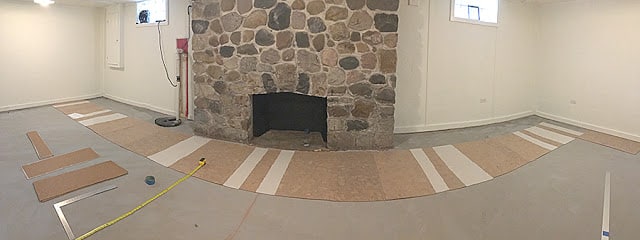 |
| Before we finalized the design, we laid out one row of tiles and took a panoramic photo to see the whole room at once. You can see we make a few changes to the planned design. |
So in Week 2 (back when I was an optimistic person who wasn’t completely freaking out about finishing this project on time), I walked you through the process of selecting the floor, which was no easy feat when the options are pretty much only limited by your imagination. We decided on a random stripe pattern in using Bleached and Alabaster colors, both in the nugget texture.
We installed click and lock bamboo floors in the bedrooms several years ago when we did our big renovation and I remember there was an issue with the delivery truck actually getting the flooring to our house. It came in several boxes and technically we should have had a forklift to move it. So it was a lovely surprise when the cork flooring showed up delivered by a regular carrier, possible only because it’s so light.
 |
| I made a list of the order in which the stripes went that we checked off as we went so we didn’t lose our place! |
Globus Cork has a really thorough installation tutorial on its website which was hugely helpful but honestly, we were overthinking it. We opened the boxes and let the cork acclimate for a few days while we prepped the floor. The key thing is that the cork, which is laid used a contact adhesive (the back of the cork tiles are pre-coated and then you apply glue to the floor) needs to go on top of clean plywood or uncoated concrete. We had our tile installer friend (a good friend to have!) do a self-leveling skim coat on top of the concrete to make everything smooth and give us a nice surface to work on.
As with any floor, the hard work is in the prep, and it’s important to make sure that everything is square. Using a chalkline, we mapped out the center, perpendicular lines and a starting line for our first row that was based off the centerline, not the wall (there isn’t a straight wall in this house).
From there it’s just a matter of rolling on the adhesive, letting it dry clear (it took about an hour with a fan blowing on it in our cool basement), and then sticking on the cork. In order to avoid stepping on the adhesive, the first few sections, each about 3 feet wide, took a bit of time. The first row is the most important, so we took a lot of time lining it up with chalkline and a square, making sure to not allow it to touch the floor until we were ready for it to stick.
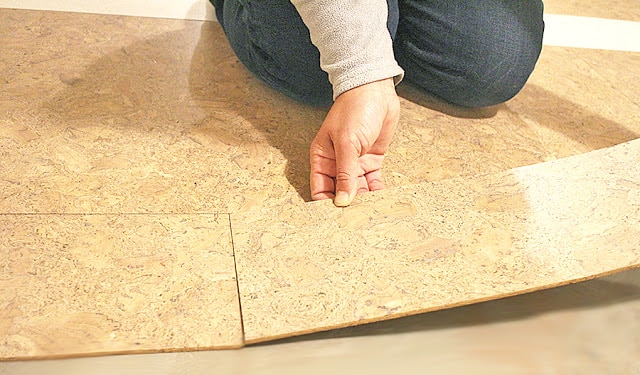 |
| Line up the inside corner of the tile first, then the long edge, followed by the short edge and lastly the freestanding corner. I applied firm pressure for a nice tight seam. |
It’s important to line up one corner at a time and just lightly let it touch (if you have to pull it up you still can, albeit very carefully, so long as you don’t press down) and then gradually get the other corners set. Set the next tile by butting it up right next to the first tile, again one corner at a time. The nice thing about the cork tiles is that they have some give, so you can really get nice tight joints by firmly butting up to the previous tile.
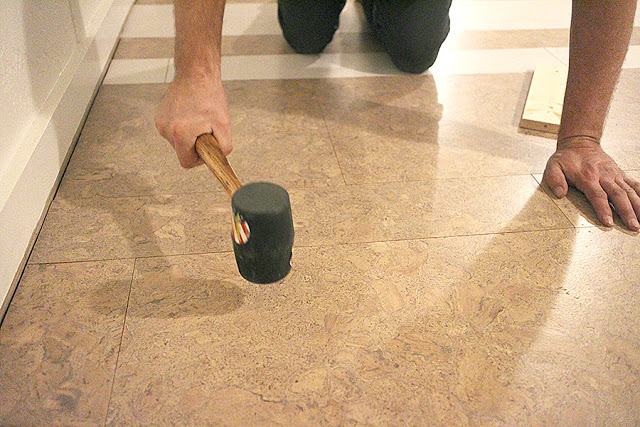 |
| Pound the tiles with a rubber mallet to seal the adhesive. We paid special attention to edges and corners. |
With the first row set, we made our way across the room, checking off each row on my cheat sheet, because it would have been easy to lose our place with the random stripe pattern. When a section was done, we pounded it down with a rubber mallet. I’m not going to lie: This was the only onerous party of the process. You have to pound the cork (not roll it) to seal the adhesive, and that’s a lot of pounding. Bonus: You can skip your regular arm workout.
There’s a few other tips and tricks we learned to installing cork flooring:
- Unless your pattern requires them to be lined up, offset your seams.
- Use a drywall T-square and a sharp utility knife (change the blade often) to cut cork.
- Take your time with the first few rows and then you can fly pretty quickly.
- A scissors or utility knife also works for cutting around odd-shaped corners or obstructions.
- Pull tiles from several boxes to account for any color variation.
 |
| If you look closely you’ll see a bump where we failed to make sure the self leveler was completely smooth. |

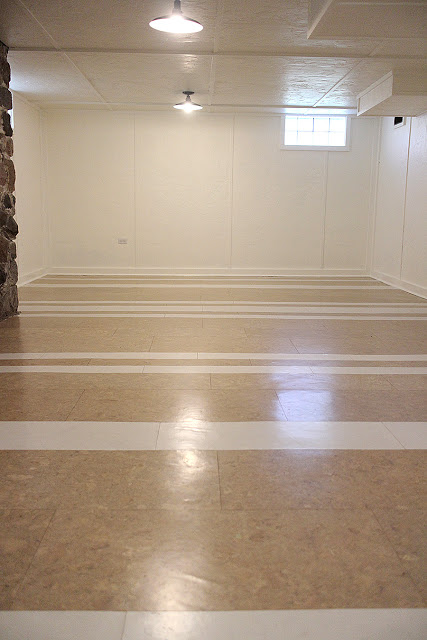
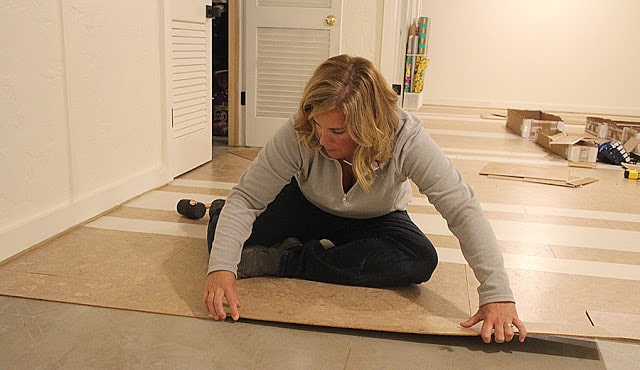
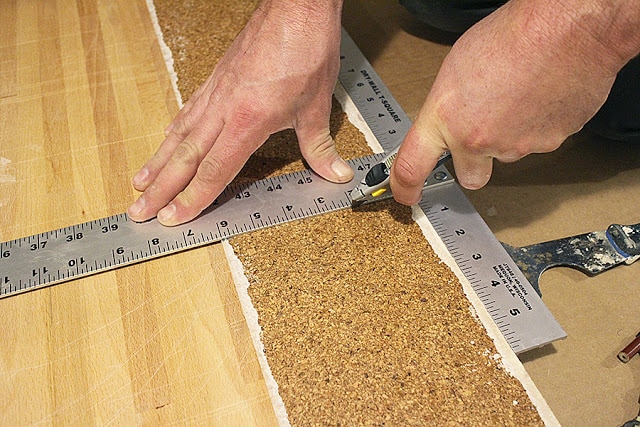
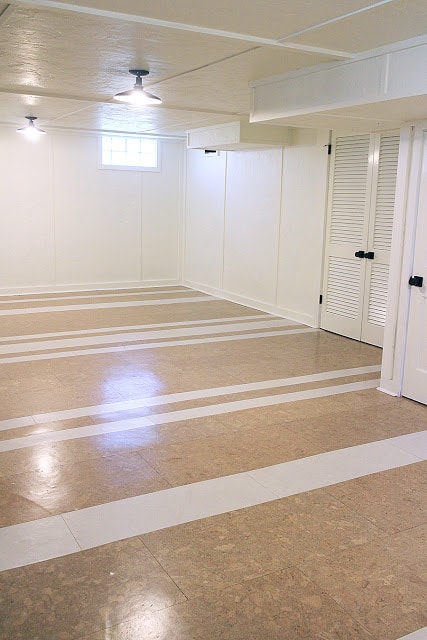



10 Responses
It’s been a few years now. How is your cork floor holding up? I’m thinking about using Globus Cirk and would really love an update. Have you had to put on a new coat of sealer? (I see it is recommended yearly on the Globus website).
It’s holding up very well, although the white color did get some wear where an office chair was. We haven’t done any additional sealer. Also, we had a mini flood a year or so ago so the entire floor was under a small amount of water. I cleaned it all up (with a bleach solution) and it dried out just fine with no long-term issues.
That’s great to hear! Thanks for the update.
Wow, I really like how that turned out, and cork would really be a great material for a basement floor. The stripes are a fun added feature 🙂
Seriously it's the perfect floor for a basement. And it was fun to do something different that I maybe wouldn't have done in my living room.
That is a really good looking floor! Love it against the fireplace stone.
Thanks, Danielle!
I think the real difference is that it no longer looks like a basement. Now it looks like a room that you WANT to spend time in.
Right? That's how I feel about it!